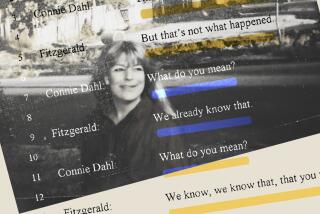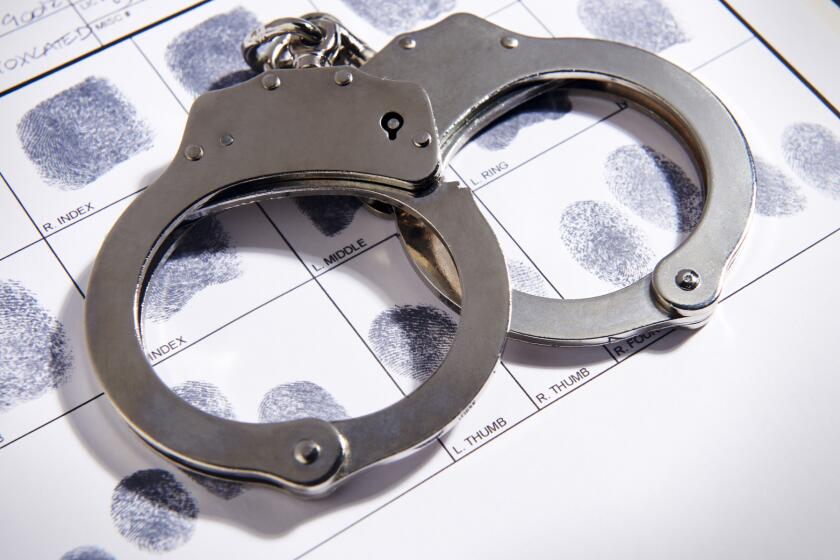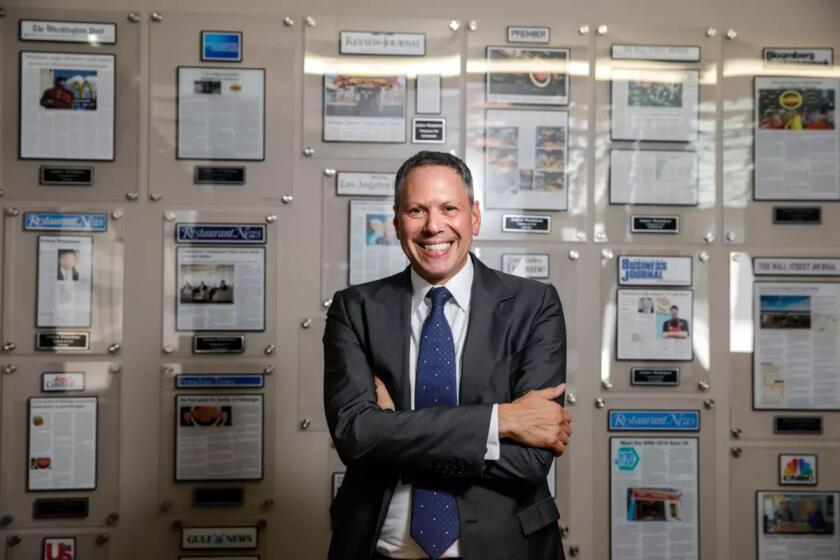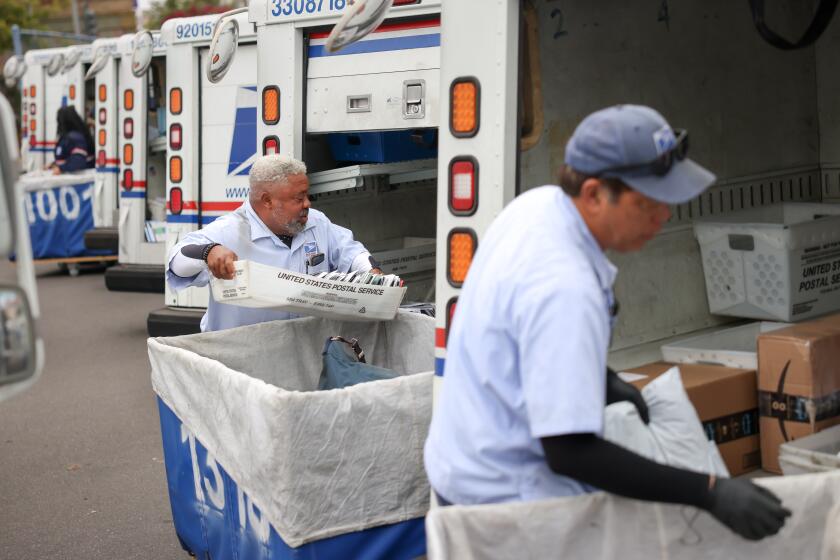A ‘well-orchestrated execution’: Mystery surrounds school official’s killing at L.A. Live

- Share via
It was the height of the dinner rush at L.A. Live, a glittering, neon-drenched complex of restaurants and bars steps from Crypto.com Arena.
Around 6 p.m. on Nov. 28, 2023, a white Ford Escape pulled out of rush hour traffic on Figueroa Street, stopping along the curb outside Fixins Soul Kitchen.
A man stepped out of the Ford, wearing a dark jogging suit with white trim, white sneakers and a baseball cap with the words “No F— Given” on the front. A black balaclava covered his face as he entered the restaurant.
L.A. Live’s security cameras captured what happened next: In front of about 20 diners and employees, he walked up behind a man eating alone at the bar, aimed a pistol with two hands and shot him in the back of the head.
At a court hearing Wednesday, Los Angeles Police Department detectives revealed how they identified the alleged shooter and a second man accused of coordinating what police called a “very well-orchestrated execution.”
Detectives testified that surveillance footage, license plate readers and an analysis of cellphone and car location data helped solve the case — but only partially.
The alleged assassins behind several recent murder-for-hire cases in Los Angeles were sloppy, authorities say, leaving behind a trail of evidence that links the killings to Chicago gang disputes.
It remains a mystery why the two defendants, alleged gang members with prior convictions for violent crimes, would target Sidney Barrett Morris, who until shortly before his death held a high-level post at Cal State Northridge.
In search of a motive, detectives got a search warrant for the victim’s CSUN email account, court records show. Morris’ colleagues told detectives he’d been investigating players on the school’s men’s basketball team who’d been accused of sexual misconduct and harassment. His co-workers theorized the investigation had something to do with his homicide.
The tip went nowhere, the lead detective told The Times.
A review of public records related to Morris, 43, revealed no obvious signs of a life in distress. No rancorous divorces or business disputes, restraining orders or recent financial trouble — nothing connecting him to the two men accused of his murder.
“I’ve been screaming to the D.A. myself: ‘What is the motive?’” Theida Salazar, a lawyer representing one of the suspects, said in an interview. “My client’s got no ties to this guy.”
Morris’ killer could have hardly picked a more conspicuous place to commit murder.
L.A. Live is bristling with cameras. Armed with a clear shot of the getaway car’s license plate, authorities found the Ford Escape two days later, set ablaze on the side of a road in Palmdale. The Hertz rental had burned down to its frame, precluding the collection of DNA evidence, Det. Joshua Byers of the LAPD’s Robbery Homicide Division testified at the hearing Wednesday.
Some police officials are pushing back after a wealthy community gifted the department scores of controversial, high-tech cameras that scan license plates.
Police license plate readers showed the Ford was in South Los Angeles the morning that Morris was killed, Byers wrote in a search warrant affidavit reviewed by The Times. Detectives obtained footage from that morning, which showed a woman park the Ford outside a building on 2nd Avenue before entering one of the units.
The unit was rented by a man named Santana Jermaine Kelly, Byers wrote.
Kelly, then 49, had been released from prison in 2019. According to a 2001 probation report reviewed by The Times, the Baldwin Village native was a longtime member of the Rollin’ 40s gang nicknamed “Ice Man.”

First arrested at 16 for carjacking a woman, Kelly went in and out of the California Youth Authority and state prison until 2000, when he was charged with following Asian patrons of the Hollywood Park Casino to their homes and robbing them, the report said.
After serving 19 years of a potential life sentence for fleeing police, Kelly was released, court records show.
The morning that Morris was killed, Byers wrote, Kelly was seen in the surveillance footage with two distinctive hats. He wore the baseball cap later seen on the shooter, the detective wrote. He was also holding a wide-brimmed straw hat that detectives saw on the footage from L.A. Live, obscuring the face of the getaway driver.
At the South L.A. building, detectives also caught a glimpse of the killer’s face, Byers testified. A man entered Kelly’s unit wearing the same clothing as the shooter. “Mask, jacket, pants, shoes — everything is identical,” Byers testified.

At L.A. Live, the killer was careful to cover his face. But in South L.A., he pulled down his balaclava, Byers testified. Detectives identified him as Phillip Pasco Clark, then 33, a convicted robber and burglar.
Arrested on suspicion of Morris’ murder on March 22, 2024, Clark called a woman from jail. “I ain’t never shot nobody,” he declared in the recorded call, which was played in court. Nor, he said, had he ever been to L.A. Live.
Clark said he told the detectives that, as a member of the Carver Park Compton Crips, he didn’t get along with the “40s,” a reference to Kelly’s gang.
Federal prosecutors say the fearsome reputation of the Rollin’ 60s gang allowed Eugene “Big U” Henley to intimidate businesses and people for decades.
The woman, furious, told Clark he shouldn’t have said anything. “Stop talking!” she yelled.
“I don’t shoot people,” Clark said. “I’m a robber. I love you.”
Detectives arrested Kelly the same day at his Palmdale home, about 10 miles from where the getaway car was torched, Det. Martin Mojarro testified. Inside his black Dodge Durango, detectives found the baseball cap from the video, Byers said.
Searching through Kelly’s phone, Mojarro testified, he found two videos time-stamped a month before Morris was killed. The detective recognized where they were filmed: an alley behind the Westchester apartment complex where Morris lived.
“This is the place,” Kelly said as he drove around the building, according to Mojarro. “Hmmm. It’s kind of secure. There’s red cameras. So he’s tight-knit. As you can see, there’s cameras everywhere.”
The second video showed a parking garage beneath Morris’ building. “I think it’d be better to get him at the other location,” Kelly said, according to Mojarro.
Kelly and Clark have both maintained their innocence. The getaway driver, whose face was covered by the straw hat, remains unidentified, according to Byers’ affidavit.
Although detectives made arrests within four months of Morris’ death, they were still no closer to knowing the motive.
Morris went through financial problems in the past. He declared bankruptcy in 2013, stating in a petition that his $76,000-a-year salary as human resources administrator at the University of San Diego couldn’t cover the $224,000 he owed in student debt, unpaid taxes and personal loans.
But Morris’ fortunes had seemingly improved by 2019, when he was hired as CSUN’s director of equity and compliance with a $150,000 salary, according to school records reviewed by The Times. By 2023, his annual pay had risen to $185,000. He had also opened a restaurant, B-You, about three blocks from L.A. Live.
Some of Morris’ colleagues at CSUN theorized his death was connected to his work. Acting on their tips, Byers in April 2024 wrote a search warrant for his CSUN email account.
The powerful prison syndicate known as the Aryan Brotherhood has moved to expand its reach, testimony and court records show, relying on gang called Public Enemy Number 1, for brutal killings, kidnappings, and drug deals on the streets of Southern California.
Before his death, Morris was investigating the CSUN men’s basketball team, Byers wrote in a search warrant affidavit. According to university records reviewed by The Times, a female student accused a basketball player of sexual assault and two other players of retaliation after she reported it in July 2023.
Morris also ran a consulting business to provide Title IX compliance training. When he hired his own firm to advise the school at a cost of $12,000, it led some CSUN officials to accuse him of self-dealing, Byers wrote in the affidavit.
Morris resigned three weeks before his death.
Byers wanted to read Morris’ emails. The notes may “provide insight into the investigations conducted by the victim,” he wrote in his affidavit, as well as reveal “any concerns, threats or fears the victim may have had.”
But after reviewing the emails, Byers told The Times, he did not find evidence to connect Morris’ death to his work at the university.
Deputy Dist. Atty. Jonathan Chung, who is prosecuting Kelly and Clark, said he still does not know the motive for Morris’ homicide.
Carmen Ramos Chandler, a spokeswoman for CSUN, said university officials have “no reason to believe that his death is related to his work.”
The school will continue to cooperate with the LAPD, she said, “to bring the perpetrators to justice.”
The preliminary hearing for Clark and Kelly will continue May 22.
More to Read
Sign up for Essential California
The most important California stories and recommendations in your inbox every morning.
You may occasionally receive promotional content from the Los Angeles Times.















